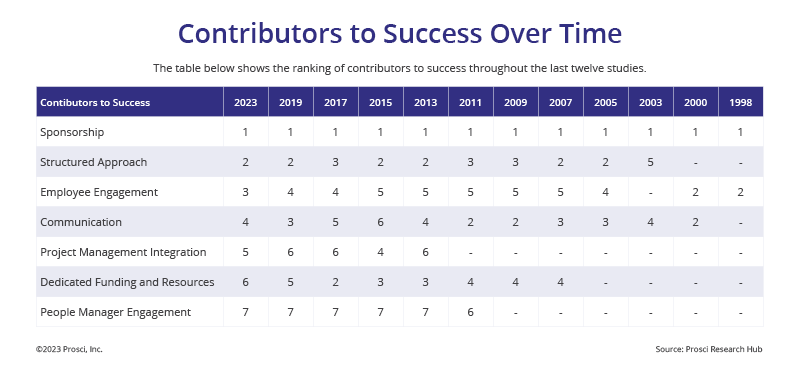The Link Between Change Management and Employee Engagement
.jpg)
6 Mins
Updated: October 30, 2025
Published: July 3, 2025

Understanding and developing the connection between change management and employee engagement will result in a resilient workforce—one that’s ready to adapt to new challenges and contribute to continued business success.
The need for organizations to create an engaged workforce where employees feel valued, motivated and invested in the company's growth is significant. However, a company needs to change to grow and maintaining engagement during transition is challenging.
In this article, we’ll explore the connection between change management and employee engagement, and explain how a structured change approach can help engage employees during a transition.
What Is Employee Engagement?
Employee engagement defines an employee's commitment and connection to their organization. It measures how emotionally invested workers are in their company's goals and how motivated they are to contribute to its success.
An engaged employee or workforce is:
- Committed – Engaged employees are committed to the organization's goals. They understand how their roles contribute to the broader objectives and are dedicated to achieving them.
- Productive – Employees who are engaged can be more productive and become more enthusiastic about their work.
- Motivated – Engaged employees are self-motivated. They find intrinsic value in their tasks and strive to perform well.
- Collaborative – In a supportive work environment, employees communicate openly and help each other achieve common goals.
- Loyal – Engaged employees are less likely to leave companies if they believe in the organization, feel respected and know that a company has their best interest at heart.
- Innovative – Employees feel empowered to propose new ideas and improvements and are motivated to implement solutions that may benefit the organization.
- Profitable – Engaged employees are more efficient, drive better business, and reduce expenses related to turnover and absenteeism.
- Positive – High employee engagement creates a positive, supportive and inclusive work culture where employees feel valued and perform better.
- Healthier – An engaged and positive work environment reduces stress and can improve physical and mental health. Gallup found that 50% of employees who are engaged at work thrive in life overall.
Given the long-term benefits, organizations continually strive to improve employee engagement through programs and strategies. However, these initiatives can fail when faced with challenges like stress, poor communication, or a lack of recognition.
Engagement is even harder to maintain during times of change when stressors are heightened and workers face additional anxiety and uncertainty.
Whether it's a restructuring or digital transformation, effectively managing change is crucial for engagement. Organizations must prioritize change management to guide and support employees through the transition and build a resilient workforce.
The Connection Between Change Management and Employee Engagement
Maintaining employee engagement is an ongoing process for most companies and becomes even more critical during a transition.
Changes are inevitable. In a survey of 4,702 CEOs, 97% of respondents report taking some steps to change how they create, deliver and capture value over the past 5 years.
Employees also understand the need for change. One-third of workers in a 2023 survey said their company won't be economically viable in 10 years if it continued on its current course.
Change management and employee engagement are deeply interconnected. Prosci research shows employee engagement is among the top three contributors to change success.

Keeping employees engaged during change by involving them in decision-making and creating a regular feedback loop gives them a sense of ownership and reduces resistance.
Evidence also shows that including employees in the change process increases the likelihood that they will adopt the change. Organizations can also improve engagement by working with change experts to support and guide staff.
Consequences of Poor Employee Engagement During Change
Mishandled change can negatively impact employee engagement, which has broader consequences for the organization. Some common challenges include:
1. Increased resistance to change
Resistance can increase as a result of poorly managed change. For example, if your plan fails to address the reasons for change or how it will impact roles and responsibilities, you could see active push-back or even passive non-compliance due to a fear of the unknown. Change practitioners should always focus on preventing change resistance first by identifying and addressing potential barriers to adoption early in the change management process.
2. Decline in morale
Ineffective change management initiatives can foster a culture of distrust and fear. When employees are not a priority during change, organizations may launch too many projects simultaneously, leading to change saturation.
Eventually, employees need help with change fatigue and become disengaged and unmotivated.
Seventy-three percent of Prosci Best Practices in Change Management research respondents claimed their organizations were near, at, or beyond the saturation point.
Level of Change Saturation

Organizations past the point of change saturation reported lower levels of employee engagement. Increased disengagement and resistance negatively affect the success of organizational change initiatives and can also harm other areas.
A demotivated workforce can be less productive and inefficient, affecting service delivery, quality of work, and customer satisfaction.
3. Higher turnover rate
Ninety percent of organizations are concerned about employee retention. While engaged employees are likely to stay, employees who experience stress and confusion through change may look for other opportunities.
High turnover incurs costs related to recruiting and training new staff. Organizations also lose experienced employees, which can deplete operational knowledge and disrupt continuity.
4. Damage to reputation
When internal issues like high turnover, low employee morale, and poor productivity become apparent, they can spill over into customer interactions. Poor internal engagement can impact service levels and product quality, ultimately impacting the company's brand, making it less attractive to both customers and potential employees.
5. Strategic misalignment
When workers aren’t engaged in a change, they may misinterpret their roles and the company's direction or be completely unaware of the change altogether. Strategic misalignment can result in wasted resources, missed opportunities, and an inability to achieve key business objectives.
Drive Employee Engagement With Change Management
The way an organization manages change is crucial to maintaining employee engagement and overall business efficiency. Change management should be a priority for organizations that want to minimize the impact on their employees.
Organizations can foster employee involvement by using a change management framework, like the Prosci Methodology, that includes employee engagement activities and provides adequate support and guidance.
Let's look at how successful change management improves employee engagement:
1. Transparent communication
Transparent, effective communication helps build awareness of the need for change, reduce uncertainties, and create trust. This is vital to maintaining engagement during transitions. This includes regular updates, open forums for questions, and clear messaging from leadership.
Change professionals can implement communication plans that clearly explain the reasons behind the change and create a compelling vision of how it benefits the workers and contributes to organizational growth.
Change management practitioners can help deliver messages to employees from their preferred senders. Prosci research shows that people prefer to receive organizational messages about the change from a high-level executive and messages about personal impacts from their direct supervisor.
Other change management activities and deliverables such as events, sponsor messages, and easily accessible information can also build awareness of the need for change.
Preferred Senders of Messages

2. Employee involvement
Involving employees in the change process can significantly boost their engagement. When employees are part of planning, implementation and problem-solving, they are more likely to understand, accept and support the change.
The Prosci ADKAR® Model can help engage diverse stakeholders of all levels in the change.
Change networks, typically made up of employees who represent impacted groups, involve more people in the process and provide an outlet to help shape the change. Stakeholder input can provide valuable insights and help make the change process more effective.
3. Training and development
Adequate training is crucial when new systems, processes or technologies are introduced. It helps employees gain the necessary skills and knowledge to adapt to changes, reducing anxiety and resistance.
Change management strategies include developing training programs to upskill employees and give them the right tools for change. This can boost employee engagement, with seven in ten people saying that learning improves their sense of connection to their organization.
Functional training and practice applying new skills are essential to helping people adopt and use changes to the way they work.
Using a model for individual change, like the Prosci ADKAR Model also helps with development by building critical knowledge and ability at the right times in the change process. People should also have access to subject matter experts and coaching as needed.
4. Recognition and rewards
Recognizing and rewarding contributions during the change can reinforce desired behaviors while boosting morale and engagement. It shows that the organization values its employees' hard work and adaptability.
Public acknowledgment in meetings or rewards in performance evaluations can motivate individuals and set a benchmark for others.
Celebrating successes, big and small, helps reinforce the behaviors and attitudes that leaders want to see. Reinforcement is crucial to prevent workers from returning to old work habits and sustain a change in the long term.
Planning for reinforcement activities also increases the chances of project success. Our research shows that 81% of participants who planned for reinforcement met or exceeded project objectives, compared to only 15% of participants who did not plan for it.
Impact of Allocating Resources to Reinforcement on Project Success

5. Leadership engagement
Leadership involvement is vital for employee engagement. Employees who see their leaders at the forefront of changes are more likely to be engaged in the change
Prosci research shows that effective sponsors actively and visibly participate in change, build coalitions of sponsorship, and communicate directly. The Prosci Methodology enables you to prepare sponsors to be effective in this critical role.
Active senior leaders or sponsors are also pivotal in championing the benefits of change and motivating their professionals by highlighting the positive impacts on the organization and each employee.
Correlation of Sponsor Effectiveness With Meeting Objectives

6. Structured approach
A detailed change approach helps focus on the people side of change. Organizations can analyze and prioritize change projects to avoid overwhelming people and improve employee engagement.
A structured change strategy enables practitioners and change professionals to understand how a change impacts people before, during and after implementation. They can plan activities to support employees throughout the process while identifying and addressing signs of change saturation.
Internal resources might not be sufficient for enterprises with multiple change projects. You may need help from expert Change Advisors who can work with you to establish and manage a portfolio approach.
Focus on Employee Engagement During Change
Change management, with a focus on employee engagement, creates a dynamic where both the organization and its employees thrive. Effective change management focuses on the people and ensures that individuals are motivated to contribute to change success. By focusing on engagement through change, you can transform potential disruptions into opportunities for improvement and growth.





